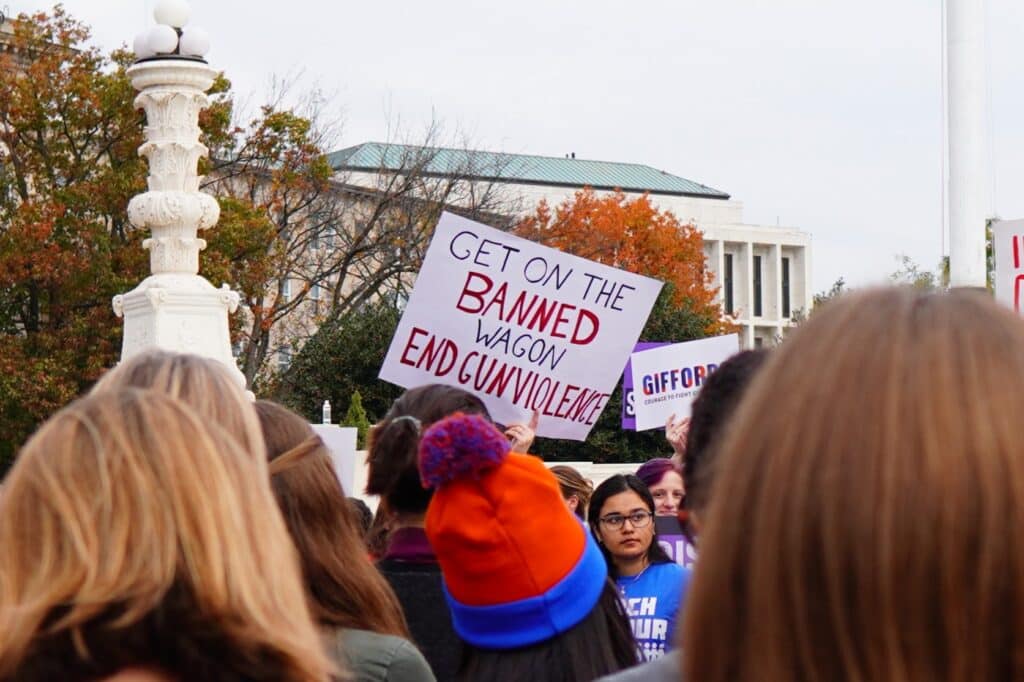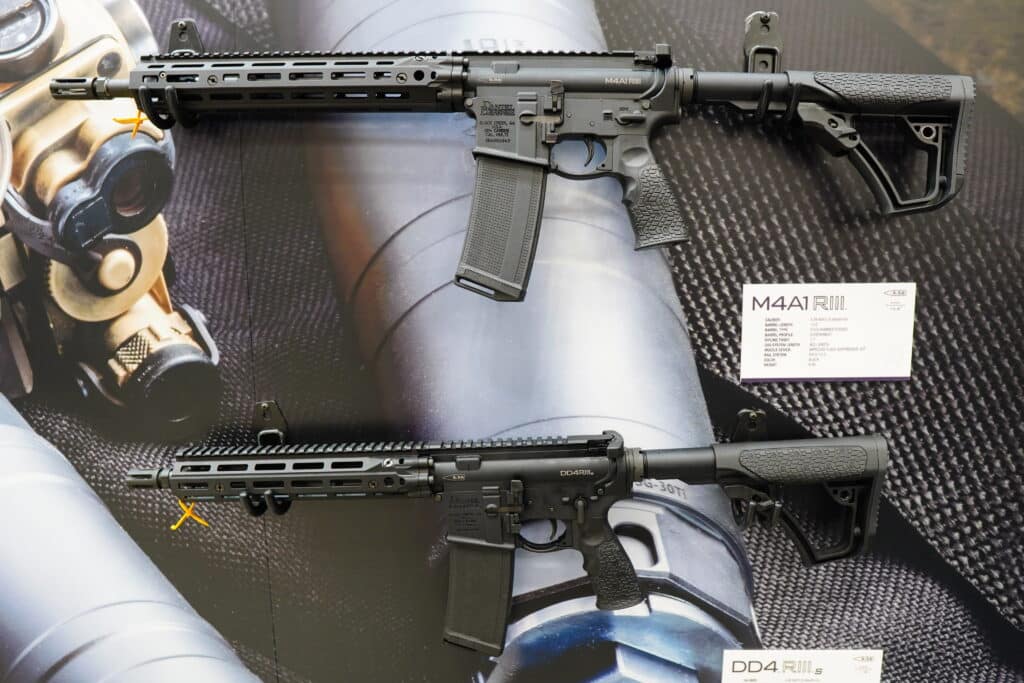There was some movement in the debate over AR-15s and similar guns this week. A group of four moderate-ish Senate Democrats introduced a new take on the traditional “assault weapons” ban.
Contributing Writer Jake Fogleman has already done a deep dive into the bill’s text. The results are pretty similar to those traditional bans. But the way they get there gets rather strange at times.
So, now it’s my turn to dive into the politics of the whole thing. Two of the key selling points of the bill are undercut by its actual contents and the Senators who aren’t on board with it (at least not yet). But I lay out why it’s still relevant and the longshot way it could become law sooner than later.
We also have news on the Federal ban on the sale of handguns to 18-to-20-year-olds. A judge has found the ban unconstitutional and blocked it nationwide.
Plus, Maryland Shall Issue president Mark Pennak joins the podcast to discuss the group’s two recent court wins.

Analysis: The Politics of Rebranding a National AR-15 Ban [Member Exclusive]
By Stephen Gutowski
This week, a group of Democratic Senators introduced a new AR-15 and ammo magazine ban. It won’t become law this year, but it could signal a shift in tactics.
Senators Martin Heinrich (D., N.M.), Mark Kelly (D., Ariz.), Michael Bennet (D., Colo), and Angus King (I., Maine), who caucuses with the Democrats, introduced the Gas-Operated Semiautomatic Firearm Exclusion (GOSAFE) Act on Thursday. The bill, which is rather poorly written, is broadly similar in its effect to a traditional “assault weapon” ban. The road it takes to get there is more winding, with a few unexpected twists and turns, but the result is a law that’s, if anything, stricter than its predecessors.
That complicates one of the key selling points for why this proposal differs from the others. Senator King emphasized that three of the four Democrats on board with the new bill had never sponsored an assault weapons ban in a recent interview with MSNBC. The group also has a reputation for being more moderate on gun policy than many other Democrats.
So, a new bill that effectively does the same thing as an assault weapon ban but is called something else may be designed to break the stalemate on the policy by attracting some moderates. But the fact this bill goes further and has weaker branding, given very few people know what a “gas-operated semi-automatic firearm” is and the bill doesn’t use the terminology right anyway, doesn’t actually appear to have made much tangible progress on that front.
The other selling point King focused on was the idea that the GOSAFE Act represents a response to the common critique that assault weapon bans are overly focused on cosmetic or ergonomic features. He argued the bill focuses on “the way the gun operates rather than what it looks like.” But the bill is poorly written on that front.
Despite claiming only to target “gas-operated” semi-autos, it defines “gas-operated” as including all kinds of operating systems. Blowback or recoil-operated guns don’t actually use the gas expelled by a fired round of ammunition to cycle the action, but they’re included in the definition anyway. And the bill consists of a myriad of incoherent expectations, such as excepting bolt-action or single-shot guns from a semi-automatic ban.
If anything, the new bill is less coherent than traditional assault weapon bans. It’s also bundled with another prohibition that’s meant to target bump stocks but actually bans any modification that could “materially increase” a gun’s rate of fire. That could outlaw things like premium triggers, recoil springs, or a whole host of other common upgrades.
These factors will likely make it just as hard a sell to anybody on the right of GOSAFE’s co-sponsors on this plan as the previous bans.
Plus, while King, Heinrich, Kelly, and Bennet may not be gun-control stalwarts like their colleague Senator Chris Murphy (D., Conn.), and some have voted against an AR-15 ban in their long carriers, they have all expressed support for an assault weapon ban before now. So, their willingness to ban the guns they’re targeting isn’t really a new development. And they didn’t get anyone on board who hasn’t expressed support in the past.
In fact, without Senators Kyrsten Sinema (I., Ariz.), Jon Tester (D., Mont.), and Joe Manchin (D., W.Va.) on board, the new bill faces the same issue the assault weapon ban that passed the House last year did: it probably can’t even get 50 Democrats to vote for it.
Even if the bill could get all the Democratic votes, it would still be nine votes short of passing. And, of course, the Republican-controlled House of Representatives is exceedingly unlikely to ever take up an AR-15 ban by any name, regardless of what the Senate does.
Still, the bill is potentially important to the American gun debate for several reasons. Though King, Bennet, Kelly, and Heinrich are a touch to the left on guns from the true center of the Senate, they have all tried to avoid highlighting gun control as a significant part of their careers. They probably have a better chance of getting more Senators on board than the other Democrats who’ve previously spearheaded ban attempts.
If they can get Tester, Manchin, and Sinema on board, that would be a sign they’re making real progress. If they get Republican Senators like Susan Collins (R., Maine) or Mitt Romney (R., Utah) to support the new effort, that would start to look more like a potential game changer.
There’s little reason to think GOSAFE could become law before the 2024 election. The polarized nature of the electorate we’ve seen over the past decade or so also makes it unlikely it could happen even after the next election. Even with how unpopular each party’s leading candidates for president are, it’s unlikely one of them can capture a majority large enough to get something as controversial as an AR-15 ban through.
The best shot Democrats would have at that is by recapturing total control of Congress and the White House, a bit of an uphill battle since the Senate map favors Republicans this year. But they would have to do that with the kind of Senate majority willing to nuke the filibuster. At that point, they could push through any legislation they wanted with a majority vote.
Of course, the Supreme Court appears primed to strike down these sorts of sales bans on guns as popular as the AR-15. But an unfavorable ruling from the Court could be overcome by packing the Court with the filibuster gone.
That’s all theoretically possible but not terribly likely.
Still, even if it’s unlikely to become law anytime soon, the proposal has the potential to become the dominant gun ban bill moving forward. If the rebrand resonates with other more-moderate lawmakers, it may replace the 30-year-old assault weapon ban proposals that haven’t made the kind of progress most gun-control activists want to see.
Podcast: Maryland Gun-Rights Leader on Series of Recent Court Victories [Member Early Access]
By Stephen Gutowski
We’re back after our Thanksgiving break, and we’ve got some big news out of Maryland.
Not only was the state’s pistol purchase law ruled unconstitutional, but the gun-carry restrictions imposed by the state’s largest county were blocked too. Mark Pennak was at the center of both cases, which is why we’ve got him on the show this week. He’s the president of Maryland Shall Issue and its lead litigator as well.
He outlined the gun-rights group’s arguments in both cases and how the two judges came down on them. He said the state didn’t have the historical backing needed to justify their handgun restrictions, and Montgomery County effectively admitted in court they were trying to outright ban gun carry. But he said his group is ready to fight on in case either appeal the decisions.
He also responded to a question raised in the dissent in the handgun case. He unpacked the idea that pistol purchase permits should be allowed to stand if they work like gun-carry permits work. He argued that’s not the right message to take away from Bruen or its concurrences.
Plus, Contributing Writer Jake Fogleman and I dissect the new attempt to rebrand AR-15 bans in the Senate.
You can listen to the show on your favorite podcasting app or by clicking here. Video of the episode is available on our YouTube channel. Reload Members get access on Sunday, as always. The show goes public on Monday.

Federal Judge Rules Handgun Sales Ban for 18-20-Year-Olds Unconstitutional
By Stephen Gutowski
The federal ban on licensed dealers selling pistols to adults under 21 is unconstitutional, according to a ruling issued on Friday.
U.S. District Chief Judge Thomas S. Kleeh said the sales ban violates the Second Amendment. He determined there isn’t a historical tradition of barring adults from buying pistols, as required for a gun restriction to be constitutional under the Supreme Court’s latest precedent. He blocked enforcement of the law against the plaintiffs in the case and all 18-to-20-year-olds nationwide.
“[B]ecause Plaintiffs’ conduct – the purchase of handguns – ‘fall[s] [within] the Second Amendment’s ‘unqualified command’ and the challenged statutes and regulations are not ‘consistent with the Nation’s historic tradition of firearm regulation,’” Judge Kleeh wrote in Brown v. ATF, “the Court FINDS 18 U.S.C. §§ 922(b)(1) and (c)(1) facially unconstitutional and as applied to Plaintiffs.”
The ruling is the latest fallout from the 2022 New York State Rifle and Pistol Association v. Bruen decision, which struck down that state’s gun-carry law and established a new test for gun laws. Numerous federal and state restrictions have been found unconstitutional since then, with many still working their way through appeals that could ultimately end up at the High Court.
Friday’s ruling allows 18-t0-20-year-olds to buy guns directly from licensed gun dealers for the first time in decades. The order goes into effect immediately but can be appealed by the Department of Justice. The department did not respond to a request for comment.
The Second Amendment Foundation (SAF) and West Virginia Citizens Defense League joined two individual plaintiffs in bringing the case. The gun-rights groups celebrated the ruling as a win for Americans, especially younger adults.
“The Biden Justice Department argued that people in this age group were not adults, which was patently ludicrous,” Adam Kraut, SAF’s executive vice president, said in a statement. “The government simply could not defend the constitutionality of the handgun prohibition, and Judge Kleeh’s ruling makes that clear.”
Judge Kleeh, a Donald Trump appointee, found there was no record of any gun sales to 18-to-20-year-olds being banned during the Founding Era.
“Defendants have not presented any evidence of age-based restrictions on the purchase or sale of firearms from before or at the Founding or during the Early Republic,” he wrote. “Defendants have likewise failed to offer evidence of similar regulation between then and 1791 or in a relevant timeframe thereafter. For that reason alone, Defendants have failed to meet the burden imposed by Bruen.”

Analysis: Breaking Down the Latest Attempt to Ban AR-15s, Ammo Mags [Member Exclusive]
By Jake Fogleman
Democratic lawmakers are taking another shot at banning a wide swath of semi-automatic firearms and ammunition magazines. But this time, they’re taking a different approach.
Senators Angus King (I.-ME) and Martin Heinrich (D.–NM) introduced the Gas-Operated Semi-Automatic Firearms Exclusion (GOSAFE) Act on Thursday. Shedding the traditional moniker of “assault weapon ban” that previous iterations of the sort have adopted, the bill instead trains its focus on, as its name suggests, “gas-operated” firearms.
The end result of the legislation would be roughly in line with traditional assault weapon and magazine ban bills, but the route to get there is unique and, at points, quite odd. It’s also almost certainly doomed to fail until at least the 2024 elections, given the current balance of power in the House and Senate. Despite this, it has the backing of nearly every major gun control organization in the country and the high-profile sponsorship of three U.S. Senators who, to this point, have never sponsored an assault weapon ban publicly before.
Therefore, the approach could prove influential if it marks a turning point for advocates looking for new ways to repackage a long-desired policy priority. For that reason, it’s worth looking in closer detail at what the GOSAFE Act does and how it gets there.
Semi-Automatic Firearms and Ammo Magazines
The marquee feature of the bill is its attempt to go after semi-automatic rifles and detachable ammunition magazines with a certain capacity.
Its restrictions on magazines are relatively straightforward. The proposal would ban the sale, manufacture, transfer, and possession of “large capacity ammunition feeding devices,” defined as any detachable device capable of holding more than ten rounds of ammunition. Existing owners of affected magazines would be allowed to maintain possession of them, but they would be prohibited from transferring them to anyone who is not an immediate relative.
However, the bill’s firearm restrictions are less clear-cut. According to its text, the measure would ban the sale, manufacture, transfer, and possession of “gas-operated semi-automatic firearms” that can accept detachable magazines. The bill’s text defines it as any semi-automatic firearm that “harnesses or traps a portion of the high-pressure gas from a fired cartridge to cycle the action,” which is fairly straightforward.
But its definition of gas operated is much more convoluted.
The bill lists several common gas systems incorporated into modern firearms by name that would be banned by the bill, including long and short-stroke pistons, direct impingement, and hybrid systems. But it also lists operating systems generally not considered “gas operated” by gun enthusiasts, such as direct blowback or recoil-operated systems, under the “gas operated” definition. As with the magazine provision, previous owners of gas-operated semi-automatic firearms would be allowed to keep them. But they can only transfer them to immediate family members.
It also prohibits the sale, manufacture, transfer, and possession of any “combination of parts” that, if assembled, could become a gas-operated semi-automatic firearm or modify a non-gas-operated firearm into one.
The exemptions to the ban are more clarifying about the ban’s intent than the actual banned firearm language itself. According to the text of the measure, firearms that are not considered illegal “gas-operated semi-automatic firearms” include guns chambered to shoot rimfire cartridges that are .22 caliber or lower, semi-automatic shotguns of all kinds, recoil-operated handguns, any rifle or shotgun with a permanently fixed magazine capable of holding ten rounds or less, and any handgun with a permanently fixed magazine of 15 rounds or less. It also specifically exempts several types of firearms from its semi-automatic gun ban that aren’t even semi-automatic in the first place, including single-shot weapons, muzzleloaders, pump actions, lever actions, bolt actions, and revolvers.
As a result, the bill takes a circuitous path to arrive at a similar—though noticably more restrictive—place most assault weapon bans arrive at. It’s ultimately a ban on all semi-automatic rifles and some semi-automatic handguns with detachable magazines.
The new bill and traditional bans both cut off sales of rifles, like the AR-15. But the new bill would also ban some that survive other bans, such as the Ruger Mini 14. As with assault weapons bans, the new bill exempts most popular semi-automatic handguns, such as common Glocks and Sigs. But the new proposal would ban all semi-automatic pistols that aren’t “recoil operated,” such as the new Laugo Alien or even Hi-Point Yeet Cannon.
“Rate of Fire” Modifications
The bill would also ban certain firearm modifications. It would ban the sale, manufacture, transfer, and possession of a “manual, power-driven, or electronic device,” that, when attached to a semi-automatic firearm, “materially increases the rate of fire of the firearm” or “approximates the action or rate of fire of a machinegun.” Tt does the same for any semi-automatic firearm modified to meet the aforementioned criteria.
Notably, this prohibition applies to all semi-automatic firearms, not just those newly designated by the bill as illegal “gas-operated” semi-automatics. This provision is aimed at controversial gun accessories like bump stocks, forced-reset triggers, or “Glock switches.” However, the bill fails to define the thresholds of when a modification “materially increases the rate of fire of the firearm,” so as to become illegal, leaving open the possibility that common upgrades like lighter precision triggers or heavier recoil springs could qualify.
Gun Buyback
The bill would establish an optional buyback program through “Edward Byrne Memorial Justice Assistance Grant (JAG) funding” to compensate individuals who voluntarily turn over their grandfathered non-transferrable firearms and ammunition magazines. But it doesn’t lay out how a buyback would work or what compensation would be offered.
Empowering the Attorney General
As with many facets of federal firearms law, the GOSAFE Act would direct the executive branch to work out many of the details needed for the law to take effect. Once passed, the measure would give the Attorney General and the ATF 180 days to compile, publish, and begin updating a list of newly banned gas-operated semi-automatic firearms on the Federal Register.
The AG’s office would then be tasked with establishing an application process for licensed gun manufacturers to get any future semi-automatic firearm designs approved before they can be sold to the public. Manufacturers must include details about the firearm’s specifications and operations, a physical sample of the firearm, any patent application, marketing materials, plans, an explanation for why the gun would not meet the gas-operated semiautomatic firearm prohibitions, and any other information requested during the application process. The bill would give the AG’s office 240 days to approve or deny a semi-automatic design application.
Once added to the list, firearms by make and model would only be eligible for removal by the AG upon a standard of clear and convincing evidence that it does not fall under the definition of a gas-operated semi-automatic firearm. The bill also creates a private cause of action that would allow “any person” to challenge the removal of a firearm from the banned list in court.
The Bottom Line
Ultimately, the GOSAFE Act represents a new approach to several longtime policy goals. With that new branding, however, comes plenty of added stringency.
If passed, it would functionally ban the sale and future possession of all semi-automatic rifles with detachable magazines, ban any semi-automatic handgun that isn’t recoil operated, limit all detachable magazines to ten rounds of capacity, and leave open the possibility that gun owners could be prosecuted for decreasing the pull weight on their firearms with aftermarket triggers. It would also put the Attorney General in charge of personally approving or denying nearly all future semi-automatic firearm offerings.
Don’t expect the new packaging to be any better received among gun-rights advocates.
That’s it for now.
I’ll talk to you all again soon.
Thanks,
Stephen Gutowski
Founder
The Reload






